
The Genealogy of Jesus Christ⁚ From Adam to Jesus
The genealogy of Jesus Christ is a fascinating topic that has been studied and debated for centuries. The Bible provides two accounts of Jesus’ lineage, one in Matthew and another in Luke. Both genealogies trace Jesus’ ancestry back to Adam, the first man, highlighting the connection between Jesus and all humanity. You can find detailed genealogies from Adam to Jesus in various online resources, including downloadable PDFs that offer visual representations of the family tree. These resources can be helpful for understanding the historical and theological significance of Jesus’ lineage.
Introduction⁚ The Importance of Genealogy
Genealogy, the study of family history and lineage, holds profound significance in various cultures and traditions. It serves as a bridge between the past, present, and future, connecting individuals to their ancestors and shaping their understanding of identity and heritage. In the context of the Christian faith, the genealogy of Jesus Christ takes on a paramount importance, as it reveals the divine plan of salvation and the fulfillment of Old Testament prophecies. The genealogical accounts in the Gospels of Matthew and Luke, while presenting distinct perspectives, provide invaluable insights into Jesus’ lineage and its implications for both Jewish and Christian faith.
The importance of genealogy lies in its ability to trace the historical and spiritual connections that shape individual lives and communities. By delving into family histories, individuals gain a deeper understanding of their roots, the challenges and triumphs faced by their ancestors, and the values and beliefs that have been passed down through generations. This exploration can foster a sense of belonging, pride, and responsibility, as individuals recognize their place within a larger narrative. For Christians, the genealogy of Jesus Christ serves as a powerful testament to God’s faithfulness and the continuity of His plan for humanity.

The genealogical accounts in the Gospels offer a glimpse into the historical and cultural context of Jesus’ life and ministry. They reveal the lineage of Jesus through his earthly father, Joseph, tracing his ancestry back to Abraham, the father of the Jewish people. This lineage connects Jesus to the promises made to Abraham and the covenant established with his descendants. The genealogies also highlight the role of significant figures in Jewish history, such as David, the king who foreshadowed the coming of the Messiah.
Two Genealogies⁚ Matthew and Luke
The New Testament presents two distinct genealogies of Jesus Christ, one in the Gospel of Matthew and another in the Gospel of Luke. These genealogies, while sharing some common elements, differ significantly in their structure and focus, reflecting the unique perspectives of each Gospel writer. Matthew’s genealogy, found in Matthew 1⁚1-17, traces Jesus’ lineage through his legal father, Joseph, back to Abraham, emphasizing Jesus’ Jewish heritage and his fulfillment of the Messianic prophecies. Luke’s genealogy, presented in Luke 3⁚23-38, takes a different approach, tracing Jesus’ lineage back to Adam, the first human being, highlighting the universal scope of Jesus’ salvation and his role as the Son of Man.
Matthew’s genealogy follows a patriarchal line, focusing on the male descendants of Abraham, David, and Solomon. It highlights the royal lineage of Jesus, connecting him to the Davidic covenant and establishing his claim as the rightful heir to the throne of Israel. In contrast, Luke’s genealogy adopts a more inclusive approach, incorporating both male and female figures, and tracing Jesus’ lineage back to Adam, the progenitor of all humanity. This genealogy emphasizes Jesus’ universal significance and his redemptive role for all people.
The differences between the two genealogies have sparked much debate and interpretation among biblical scholars. Some argue that the discrepancies reflect the different purposes of the Gospels, with Matthew emphasizing Jesus’ Jewish identity and royal lineage, while Luke focuses on Jesus’ universal appeal and his role as the Savior of all humankind. Others suggest that the genealogies may represent different lines of descent, one through Joseph and the other through Mary, highlighting the dual nature of Jesus as both the Son of God and the Son of Man. Regardless of the specific interpretation, the two genealogies offer valuable insights into the historical and theological significance of Jesus’ lineage.
The Genealogy of Matthew
Matthew’s genealogy, presented in Matthew 1⁚1-17, is a carefully constructed list of names that traces Jesus’ lineage back to Abraham, the patriarch of the Jewish people. This genealogy emphasizes Jesus’ Jewish heritage and his fulfillment of the Messianic prophecies that promised a descendant of David who would rule over Israel. The genealogy is structured in three distinct sections, each containing 14 generations, a number that is significant in Jewish numerology and signifies completeness and perfection.
The first section of Matthew’s genealogy covers the generations from Abraham to David, highlighting the historical lineage of the Jewish people and their connection to the Davidic covenant. The second section traces the lineage from David to the Babylonian exile, encompassing the period of Israel’s political and spiritual decline. The third section focuses on the generations from the exile to Joseph, Jesus’ legal father, signifying the restoration of Israel and the arrival of the promised Messiah. Matthew’s genealogy is not simply a list of names; it is a carefully crafted narrative that reveals the historical, theological, and prophetic significance of Jesus’ lineage.
The genealogy highlights the fulfillment of Old Testament prophecies regarding the coming Messiah, establishing Jesus as the rightful heir to the throne of David. It also emphasizes the importance of Jesus’ Jewish identity and his role as the Savior of the Jewish people. Matthew’s genealogy serves as a bridge between the Old and New Testaments, demonstrating the continuity of God’s plan of salvation and the fulfillment of his promises through Jesus Christ.
The Genealogy of Luke
Luke’s genealogy, found in Luke 3⁚23-38, stands in contrast to Matthew’s, presenting a different perspective on Jesus’ lineage. While Matthew focuses on Jesus’ Jewish heritage and his connection to the Davidic line, Luke’s genealogy traces Jesus’ ancestry back to Adam, the first man, emphasizing Jesus’ universal significance as the Savior of all humanity. Unlike Matthew’s genealogy, which starts with Abraham and traces forward, Luke’s genealogy begins with Jesus and works backward in time, culminating in Adam.
Luke’s genealogy includes prominent figures from Jewish history, such as Noah, Abraham, David, and Joseph, but it also includes figures from the broader human lineage, highlighting Jesus’ connection to all people. The genealogy also reveals the human side of Jesus, emphasizing his shared humanity and his identification with the human experience. Luke’s genealogy, while rooted in Jewish tradition, transcends national and ethnic boundaries, showcasing the universal scope of God’s love and salvation.
The genealogy in Luke emphasizes Jesus’ role as the Son of God, the ultimate descendant of Adam, and the promised Messiah for all people. It highlights the continuity of God’s work in creation and redemption, tracing the lineage of humanity back to its origin and culminating in the arrival of the Savior. Luke’s genealogy offers a broader perspective on Jesus’ lineage, emphasizing his universal significance and his role as the Savior of all humanity.

Differences and Similarities between the Genealogies
The genealogies of Jesus in Matthew and Luke, while both tracing his lineage back to Adam, present some notable differences. The most striking difference lies in their starting points. Matthew’s genealogy begins with Abraham, focusing on Jesus’ Jewish heritage and his connection to the Davidic line. Luke’s genealogy, on the other hand, starts with Jesus and works backward, emphasizing his universal significance as the Savior of all humanity. This difference reflects the distinct theological perspectives of each Gospel writer.
While the genealogies diverge significantly in their starting points, they share a common lineage from Abraham to David. This shared section highlights the importance of Jesus’ Jewish heritage and his connection to the royal line of David, fulfilling prophecy and demonstrating his rightful claim to the throne of Israel. However, from David onward, the genealogies diverge again, reflecting the different perspectives of Matthew and Luke on Jesus’ lineage. Matthew traces Jesus’ lineage through Solomon, while Luke traces it through Nathan.
Despite these discrepancies, the genealogies in Matthew and Luke both emphasize the historical and theological significance of Jesus’ lineage. They demonstrate Jesus’ connection to the Jewish people, fulfilling prophecy and offering a messianic lineage that links him to the royal line of David. They also highlight the universal scope of his mission, tracing his lineage back to Adam and emphasizing his role as the Savior of all humanity.
The Significance of the Genealogies
The genealogies of Jesus in Matthew and Luke, while seemingly complex lists of names, hold profound theological significance. They serve as a testament to Jesus’ identity as the Messiah, fulfilling the prophecies about the coming King of Israel who would be descended from David. By tracing Jesus’ lineage back to Abraham, the genealogies highlight his connection to the Jewish people and his role as the fulfillment of God’s covenant with them. Moreover, the inclusion of David in both genealogies emphasizes Jesus’ royal lineage, establishing him as the rightful heir to the throne of Israel.
Beyond highlighting Jesus’ Jewish heritage, the genealogies also point to his universal significance; Luke’s genealogy, tracing Jesus’ lineage back to Adam, emphasizes his role as the Savior of all humanity, not just the Jewish people. This connection to Adam underscores the universality of Jesus’ mission and his ability to redeem all who believe in him. The genealogies also showcase the divine purpose and intricate plan that God had for the salvation of humanity, culminating in the birth of Jesus, the promised Messiah.
Furthermore, the genealogies serve as a powerful reminder of the interconnectedness of history and the fulfillment of God’s promises. They demonstrate how God works through generations, fulfilling his purposes through seemingly ordinary individuals. By tracing Jesus’ lineage back to Adam, the genealogies offer a glimpse into the grand narrative of redemption that spans centuries, culminating in the coming of the Messiah.
The Genealogy in the Context of Jewish Tradition
The concept of genealogy was deeply ingrained in Jewish tradition. It played a crucial role in establishing identity, lineage, and legal rights. Genealogies were meticulously recorded and passed down through generations, serving as a testament to a family’s history and connection to their ancestors. This emphasis on lineage was particularly relevant in the context of the Davidic covenant, where the promise of a future king descended from David was central to Jewish hopes and expectations. Therefore, Jesus’ genealogy in the Gospels, tracing his lineage back to Abraham and David, resonated deeply with Jewish readers and offered compelling evidence for his claim as the Messiah.
Furthermore, the inclusion of specific individuals in Jesus’ genealogy, such as Ruth, a Moabite woman, or Tamar, a daughter-in-law who disguised herself as a prostitute to conceive a child, highlights the complex and often unconventional nature of lineage in Jewish tradition. These stories showcase the importance of God’s faithfulness and his ability to work through unexpected circumstances to fulfill his promises. The genealogies also demonstrate the interconnectedness of seemingly disparate individuals and events, revealing how God weaves together the tapestry of history to achieve his ultimate purpose.
In essence, understanding Jesus’ genealogy within the context of Jewish tradition provides a deeper appreciation for the theological significance of his lineage. It underscores the importance of God’s covenant promises, the complexity of history, and the intricate web of relationships that ultimately led to the arrival of the Messiah.
The Genealogy as a Bridge Between the Old and New Testaments
The genealogies of Jesus in Matthew and Luke serve as a vital bridge between the Old and New Testaments. They highlight the continuity of God’s plan of redemption, demonstrating how Jesus, the Messiah promised in the Old Testament, fulfills the prophecies and covenants established centuries before his birth. By tracing his lineage back to Abraham, the father of the Jewish people, and David, the king who ruled over a united Israel, Jesus’ genealogy establishes his rightful place as the heir to the Davidic throne, a key element in the Messianic prophecy.
Moreover, the genealogies reveal the interconnectedness of the Old and New Testament narratives. They showcase how God’s work in the lives of individuals throughout history – from Adam and Eve to Abraham and David – culminates in the coming of Jesus. This connection between the Old and New Testaments emphasizes the unity of God’s plan and underscores the idea that Jesus is not merely a new figure but the fulfillment of God’s promises to his people throughout history.
The inclusion of individuals like Ruth, a Moabite woman, and Tamar, a daughter-in-law who engaged in unconventional means to conceive a child, further emphasizes the continuity of God’s work. These figures highlight God’s ability to use seemingly flawed individuals and unexpected circumstances to achieve his purposes. This perspective underscores the overarching narrative of redemption and the ongoing work of God, regardless of the historical context or the flaws of humanity.





No comment yet, add your voice below!